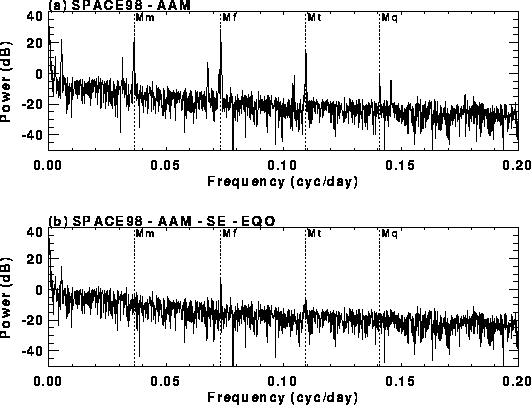 |
|
 |
 |
|
 |
Long-Period Tidal Variations in Rotation Rate
As with the diurnal and semidiurnal ocean tides, the long-period ocean tides also cause respective tidal variations in the Earth's rotation both from moment of inertia changes and from tidal currents. However, in contrast to the diurnal and semidiurnal ocean tides, the long-period ocean tides are of sufficiently long period to be dominated by a response that coincides, or is in equilibrium, with the forcing equipotential surface. The long-period tidal potential is axisymmetrically distributed over the Earth and therefore the long-period ocean tides principally cause variations in the Earth's polar moment of inertia. As such, for the long-period ocean tides, the inertia term is most important to variations in the Earth's rotation rate, while both inertia and current terms are important for polar motion variations. In fact, the contribution of the long-period ocean tides to variations of the Earth's rotation rate are an order of magnitude larger than contributions from the diurnal or semidurnal ocean tides. It should be noted that the long-period solid Earth tides also translate directly into changes in the polar moment of inertia of the Earth and the long-period solid Earth tides actually provide the first order contribution to long-period tidal variations of the Earth's rotation rate, while the long-period ocean tides provide the second order contribution.

Spectra of SPACE98 length of day time series after removing contribution
from the diurnal and semidiurnal ocean tides
The figure above illustrates the dominance of the long-period tidal
variations of the Earth's rotation rate for periods longer than a few days.
These spectra were derived from the SPACE98
length-of-day time series generated by Richard Gross at the Jet Propulsion
Laboratory. This time series removes all contributions from the diurnal
and semidiurnal ocean tides. Figure (a) provides spectra after removing
from the SPACE98
time series the contribution from atmospheric angular momentum
(AAM
) usingthe NCEP reanalysis. The principal peaks are observed at the monthly
(Mm), fortnightly (Mf), termensual (Mt, or nine day), and seven day (Mq)
tidal constituents and their respective sidebands. Figure (b) then illustrates
the significant reduction in energy at the long-period tidal frequencies
after additionally removing contributions from the long-period solid Earth
tides (SE), and equilibrium representations of the long-period ocean tides
(EQO).
Back to previous page.